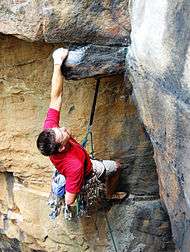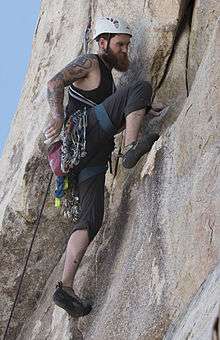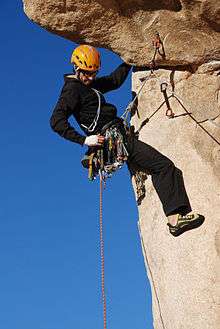Traditional climbing
| Part of a series on |
| Climbing |
|---|
 Trad climber in New River Gorge, West Virginia, USA |
| Background |
| Types |
| Lists |
| Terms |
| Gear |
| Climbing companies |
|


Traditional climbing, or trad climbing, is a style of rock climbing in which a climber or group of climbers place all gear required to protect against falls, and remove it when a pitch is complete. Traditional bolted face climbing means the bolts were placed on lead and/or with hand drills. The bolts tend to be much farther apart than sport climbs. For example, a trad bolted route may have bolts from 15–75 feet apart. A sport route may have bolts from 3–10 feet apart, similar to a rock climbing gym. The term seems to be coined by Tom Higgins in the piece "Tricksters and Traditionalists" in 1984. A trad climber is called a traditionalist.[1]
Characterizing climbing as traditional distinguishes it from bolted climbing-either trad bolted or sport climbing (in which all protection and anchor points are permanently installed prior to the climb - typically installed while rappelling) and "free solo climbing" (which does not use ropes or gear of any kind). However, protection bolts, pitons and pegs installed while lead climbing are also considered "traditional" as they were placed during the act of climbing from the ground-up rather than on rappel, especially in the context of granite slab climbing.
Before the advent of sport climbing in the United States in the 1980s, and perhaps somewhat earlier in parts of Europe, the usual style of unaided rock climbing was what is now referred to as traditional-either bolted face climbs or crack climbs. In trad climbing, a leader ascends a section of rock placing his or her own protective devices while climbing. Before about 1970 these devices were often limited to pitons; today they consist mainly of a combination of chocks and spring-loaded camming devices, but may less commonly include pitons which are driven with a hammer.[2] John Long's 1989 technique manual How to Rock Climb (Chockstone Press) used the term "sport climbing" repeatedly in reference to what is now considered "traditional climbing".
Important features of trad climbing are a strong focus on exploration, and a strict dedication to leaving nature unblemished by avoiding use of older means of protection such as pitons, which damage the rock. This evolution in climbing ethics has been attributed to the efforts of Yvon Chouinard, Royal Robbins, and many others, who pioneered the "leave no trace" ethic in climbing.[3]
Trad gear
The term gear in climbing generally refers to equipment used during climbs (except harness, shoes, chalk bags, and chalk). Gear or protection are mechanical devices that provide safety, either by allowing greater stability in making a move (as in the case of aid climbing) or by dampening force and reducing the distance of a fall. The suitability of individual types of gear depends on the surface and formation of the rock face. The phrase placing gear denotes the act of setting a piece of gear into the rock face and then attaching the rope (via carabiner) before ascending higher. In the event of a fall, the gear acts as a catch-point for the rope, thus preventing the climber from hitting the ground. Gear is placed at frequent intervals to avoid becoming too "run out", and provide protection in the case of a fall.
Nuts started being developed in the 1950s in the UK, with the original pieces being made from discarded machine nuts with slings threaded through them. Urban legend suggests the first nuts were ones taken from the Snowdon Mountain Railway[4]. These gradually developed into purpose built nuts.
Prior to about 1970 in the United States, climbing relied mainly on pitons; other types of gear such as nuts, Hexcentrics, Tricams and spring-loaded cams were largely unknown or did not exist. As other variants of climbing were not nominally in existence as well, all climbing was in effect trad climbing until the early 1980s when sport climbing emerged in Europe.
Since the 1970s, developments in protective gear have made climbing much safer and more dynamic. For example, nuts—removable pieces of metal which could be jammed into cracks to support weight during a fall but could be removed at the end of a climb—helped fuel trad climbing's growth in popularity and safety. Contemporary protective gear used in trad climbing consists of removable protective devices such as:
If a climber is soloing they remove placed gear while rappelling back down the climb[5]; if climbing with a partner the second climber will clean the gear during his or her ascent up the pitch.
In protecting the lead climber in both trad and sport: Carabiners and slings are used to connect the gear to the climber's lead rope, so that in the event of a fall, the rope can be used (by the belayer below) to catch the falling climber. Modern traditional climbs occasionally have fixed gear (pitons or bolts) in places where there are no opportunities to place adequate removable gear. It is considered bad style to install new protection bolts or pitons on existing climbs that can be completed without them.[6]
Many of the existing pitons, pegs and bolts from the first ascents of routes done many years ago, are now considered to be in bad condition having suffered from the weathering. This is especially present on sea cliffs where the salt nature of the air has sped up the oxidisation to create rust and weaken the protection.[7]
Commonly used knots
A number of knots are required for traditional climbing, to create anchors, to tie in the climbers and even to be used during the climb.
- Figure-eight loop is commonly used to tie in the climbers at both ends
- Clove hitch is used when building an anchor using the rope and sometimes to make a climber safe quickly at a belay ledge
- Alpine butterfly can be used to tie a climber into the middle of a rope
- Munter hitch is commonly used to belay without a belay device
- Slip knot or running knot, can be used during a climb to sling a protrusion of rock known as a chickenhead or any trees that may be on the route
- Lark's foot or girth hitch, is used to attach slings to trees or spikes and also to a climbers harness
- Double figure-eight loop is used for building a master point off of the climbing rope.
- Water knot is used for connecting two pieces of webbing together.
- Double bowline is used for tying in, or anchoring around a fixed object.
Anchors
When a climber has reached the top of a climb an anchor must be set up to allow the leader to bring up the seconder safely. An anchor has a number of different components which should be put together in a redundant way to make the anchors safe.
- Protection: An anchor typically consists of 3–4 pieces of protection with the minimum being two pieces. The anchor placements are chosen such that a failure of any single piece will not lead to loss of integrity of the entire system.
- Cordelletes/Web-o-lettes/Slings/Rope: These are used to tie the pieces of protection of the anchor together with equalised tension using the above-mentioned knots.
- Carabiners: Are used to connect the pieces of protection to the rope and also to attach the belay device and lead climber to the anchor.
- Locking Carabiners have a twistable ring that will close over the gate to prevent accidental opening
- Non-Locking Carabiners do not have this safety ring, and are therefore more likely to be accidentally opened by rope or systems. When using non-locking carabiners in place of locking carabiners, they are place with the gates opposite and opposed, so that it is significantly unlikely that both will be opened simultaneously.
Bailing
In some cases a traditional climb may be too difficult or there might not be enough time to complete the climb before dark. The lead climber may decide to abort the climb (or "bail") and descend to the ground before reaching the top. To do this an anchor is set up mid-climb and whatever protection that is required to ensure a safe descent is left on the rock after the climbers abseil to the ground.[8]
Typical sequence
- Leader places gear on harness
- Leader ties into the rope using a Figure 8 knot.
- Second climber ties into the other end of the rope.
- Second puts the leader on belay using a belay device or munter hitch.
- Leader climbs up and places the first piece of protection. The first piece of protection should be multi-directional. This means that it should not be able to be pulled out if it moves up or down.
- Leader uses a quick draw or extended draw to connect the first piece to the rope.
- Leader climbs upwards and places the second piece of protection and repeats until the top of the climb.
- Leader creates an anchor and attaches himself at two points to become safe.
- Seconder takes leader off belay.
- Leader pulls up all the rope until there is no slack between the leader and seconder
- Leader puts second on belay. Leader says "On me" for safety and verification.
- Seconder says "On you" to signify the seconder is on belay.
- Second climbs up and removes the protection the leader has placed on the way up.
Types of rock
A number of types of rock are climbed on each with a varying degree of suitability for traditional climbing. Some examples are sandstone, granite and limestone.
Ethics
While it may arguably be more dangerous than sport climbing, traditional climbing leaves little or no trace of climbing, which preserves the natural environment of the cliff face (though many significant first ascents in the U.S. done with a combination of permanent anchors or bolts and crack fitting hardware were termed "traditional" when the term was first coined—see climbing styles). Sport climbing, on the other hand, requires bolts to be permanently drilled into the rock face providing the exclusive or primary means of protection. The difference between sport and traditional or "trad" styles has caused some periodic contention in the rock climbing community as the respective camps debate the merits of the differing styles.
References
- ↑ "Tricksters and Traditionalists".
- ↑ "The Story Of The First Wild Country Friend". UKClimbing. 10 September 2011. Retrieved 26 May 2018.
- ↑ Essay by Yvon Chouinard & Tom Frost
- ↑ "Nut's Story: 2001, a Nut Odyssey". www.needlesports.com. Retrieved 2017-05-26.
- ↑ Andy Kirkpatrick. "Rope soloing 101 part 1". Retrieved 26 May 2018.
- ↑ "Retro Bolting". Retrieved 26 May 2018.
- ↑ Jeff Achey (24 April 2014). "Built to Last? The Hidden Dangers Of Climbing Bolts". Climbing.com.
- ↑ Long, John, How to Rock Climb! 4th ed., Falcon Publishing, Inc., 2004, p. 168. ISBN 0-7627-2471-4